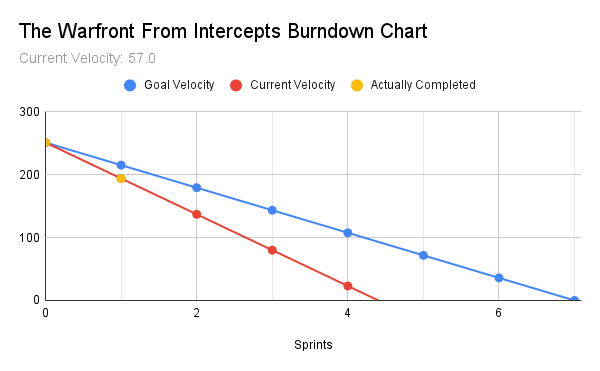Production Blog 1
Hello, I’m Natalie Hoffmann and this is the first production blog for The Warfront From Intercepts! I’m looking forward to sharing all the amazing work that the team has done throughout the duration of this project. Our team is comprised of ten people, and the game was designed by Justin Lam. If you would like to hear more about the design process for the game, you can read Justin’s blog.
The Warfront From Intercepts is a puzzle strategy game where the player sifts through papers to find the enemies battle strategy. Taking place in a fictional reality of WWII, the player will take the roll of a general for the country of Fenrir. In order to defeat the Gorik Empire, the player must uncover hidden messages, decrypt messages, and separate false intel from true plans. The player will use what they have uncovered within a ten minute time limit to place their troops on the battlefield and hope for victory in securing another territory.
The first sprint started Tuesday, September 3 and ended Thursday, September 12, giving us a little less than two weeks to get started. Despite the shorter sprint time, our team got a lot of great work done!
Level Design
The focus for our level designer, Miguel Antonio Fuentes, was to make the annotated map of the war map. The challenge was ensuring that there was a good balance of terrain varieties because of the buffs and debuffs certain terrain has on specific units. Having too much of one terrain would lead to less variety in gameplay, making it less fun. The placement of territories on each terrain was also important so one side didn’t have any advantage over the other at the start of the game.
Programming
The goal of our programmers was to create the backbone of the game logic and the main controls for the game. We had to start by generating the enemy’s unit deployment because all other logic in the game is very closely related to that aspect. Once the random unit generation was created, the messages would be created off of that information, ensuring that the player is receiving accurate information from the messages that are meant to be true. We also had to make classes for the units, making it easier to add more unit types later on if time allowed. Along with the unit generation, we needed to make sure we had a timer so the player’s limitation was there at the beginning. Most of the challenge comes from the limited amount of time the player has, so ensuring that the timer is complete is really important for an interesting game. Lastly, some of the main controls for the player is being able to focus in the corkboards and moving papers onto and around the corkboard. This allows the player to easily refer to messages they deemed important and hints generated at the start of the round.
Bryan Ramirez
Rodrigo Lopez-Patino
Mario Garcia
Modeling
The setting of the game takes place in a war room, designed to make the players feel like they’re in the 1930s-1940s. We needed to complete the models for the war room ananalysis room, since those elements are part of the core loop of the project. The war room itself would be seen the most by the player, and it requires things such as the corkboards, a desk, and a clock. The analysis room has two main features, the chemical station and the AT Machine. The chemical station needed a chemical desk, a tray, chemical bottles, a chemical shelf, and a chemical waste bin. All of these elements will be used by the player in order to uncover messages written in invisible ink. The AT Machine only required one model, and it’s designed after the Turing Machine used in WWII to crack the Enigma Machine. In our game, the AT Machine will be used to decipher text that has been encoded by a Vigenère cipher or a Caesar cipher.
Peter Gahl
Sarah Youngdahl
Andrew Olsen
Jax Potmesil
Over the course of the sprint, the team completed 57 points of the 88 assigned. In the next sprint, we plan to have a playable electronic prototype that shows off the core gameplay loop. We hope to gather valuable playtest information from the prototype to ensure we are pushing the game in the right direction. In future sprints, our team will add more interesting features such as events and terrain effects as well as create an even more visually appealing environment. Check in for future posts about the production and design of The Warfront From Intercepts!

Get The Warfront From Intercepts
The Warfront From Intercepts
Hidden amongst the fake messages are the real plans of the enemy's attack.
| Status | In development |
| Author | CAGD |
| Genre | Strategy, Puzzle, Simulation |
| Tags | World War II |
More posts
- Designer Postmortem - The Warfront From InterceptsDec 12, 2024
- Production Blog 6 - PostmortemDec 12, 2024
- Designer Blog 6 - The Warfront From InterceptsNov 24, 2024
- Production Blog 5Nov 14, 2024
- Designer Blog 5 - The Warfront From InterceptsNov 12, 2024
- Production Blog 4Oct 31, 2024
- Designer Blog 4 - The Warfront From InterceptsOct 28, 2024
- Production Blog 3Oct 17, 2024
- Designer Blog 3 - The Warfront From InterceptsOct 17, 2024
- Production Blog 2Oct 03, 2024
Leave a comment
Log in with itch.io to leave a comment.